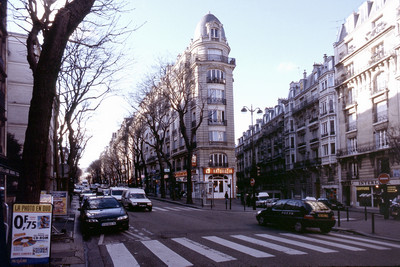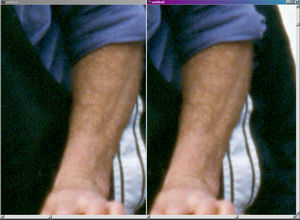HOME
TOPICS
ABOUT ME
I was so impressed with that scanner that I ended up buying it.
Al Fasoldt's reviews and commentaries, continuously available online since 1983
PrimeFilm 35mm scanner performs well at a price you won't believe

Photo of Alaskan fishing shack scanned at 1800 dpi by the PrimeFilm scanner. Photo by Nancy Fasoldt. Click on the image to view the original scan. (Warning: The original scans of all photos shown here are quite large.)
August 19, 2001
By Al Fasoldt
Copyright © 2001, Al Fasoldt
Copyright © 2001, The Post-Standard
You get what you pay for. Or so I thought when I reviewed a super-expensive 35mm scanner from Polaroid earlier this year.
The Polaroid SprintScan 4000 is a wonderful scanner, and I hated to send my review unit back after trying it out. But oh, that price! The SprintScan has a list price of $2,500. A computer peripheral that costs more than most PCs is hard to justify, and the more I thought about the cost of that scanner, the more I wondered if I could find a good one for a lot less.

Paris street near the Moulin Rouge, scanned at 1800 dpi. Photo by Al Fasoldt. Click on the image to view the original scan.
So I set off on a Web journey in search of the perfect real-world 35mm scanner -- one that did a good job and didn't cost two arms and a leg. I was hoping to find one in the $400 range. I wasn't looking for a "flatbed" scanner, the kind that has a big, flat lid. I was looking for an inexpensive scanner designed solely for 35mm negatives and slides.
What I discovered made me dance in my cheapskate boots. After reading about a new scanner from Pacific Image Electronics, a Taiwan company with offices in California, I asked PIE to lend me one of its PrimeFilm 1800 scanners. I was so impressed with that scanner that I ended up buying it a few weeks later.
But wait a minute. Hold everything. Honesty compels me to inform you that the PrimeFilm 1800 isn't in the $400 price range. More accurately, one of them isn't in the $400 range. Two of them would be.

Central New York blues singers Betty Lee and Steve Westcott, in a jam session on Lee's back porch. Image scanned at 1800 dpi. Photo by Al Fasoldt. Click on the image to view the original scan.
Do I have your attention yet? For $400, you could get one PrimeFilm scanner for yourself and one for your sister-in-law. You could buy one for the home and one for the office.
You don't need to pinch yourself. You're not dreaming. You can buy the PrimeFilm 1800 slide and negative scanner for less than $200 if you shop around. A check of prices on the Internet in the summer of 2001 showed a range from $160 to $190.
Those prices are almost unbelievably low. If you've been hoping to find a way to scan your 35mm slides and negatives so you can e-mail them to family members or post them on your personal Web site, the PrimeFilm 1800 would be ideal. (It's probably not what you should get if you're a professional or a very serious, semi-pro photographer, however. I'll explain why in a minute.)
The PrimeFilm 1800 is simple to hook up. It connects to PCs and Macs by USB. After struggling for years with dumdum scanner hookups of one kind or another, I needed only a few minutes to get the PrimeFilm 1800 working. I plugged one end of a spare USB cable into the back of the scanner and the other end into the back of my PC, double clicked on the installation program and started scanning. It was that simple.
The PrimeFilm scanner's USB connection should work with any recent Windows PC or Apple Macintosh. The scanner is quite small -- about the size of a large book -- and weighs, at most, a pound or two. It would easily fit into a briefcase or book bag if you wanted to tote it to the office or if you needed to carry it from a computer lab back to your dorm at school.

Polaroid SprintScan scan, left, was made at the scanner's highest optical-scan rating, 4,000 dpi. PrimeFilm scan, at right, was interpolated within the scanner to achieve 4,000 dpi. Both images are extreme enlargements of the same area of a slide.
Companies that make scanners usually urge customers to make sure their computers have plenty of memory. But the only PC that wasn't already occupied in our home network was a 1996 model Aptiva, with 48 megabytes of RAM and a 200 MHZ Pentium processor. I did all my scanning on this slowpoke Aptiva, without a problem.
The PrimeFilm 1800 handles one slide or negative at a time. A snap-down plastic door holds each image securely.
There are two areas in which the PrimeFilm 1800 can't compete with expensive scanners. The most important drawback is its limited resolution. The other is a small amount of noise, shown as speckles or uneven splotches, in the dark areas of slides.
The PrimeFilm 1800 scans at a resolution of 1800 dots per inch (dpi). This might sound like a big number if you're used to flatbed scanners, but don't let the rating confuse you. Flatbed scanners can do a fine job if they have 300 to 600 dpi resolution. But 35mm scanners, which scan a very small area of film, need all the resolution they can get.
What this means in everyday terms is simple. The PrimeFilm scanner is fine if you want to create Web-page images (they don't need high resolution) or if you want to print 5 X 7 photos of your negatives and slides (that's the maximum image enlargement before the 1800-dpi scans start to look pixely). But it's not what professionals and serious amateurs should choose if they want to make large photographic prints.
Since 1800 dpi is the scanner's maximum optical resolution, you might be surprised to see higher settings (for as much as 19,200 dpi!) in the scanner software. Does this mean you can scan at the resolution of the Polaroid scanner -- 4,000 dpi -- and get the same quality scans as the Polaroid SprintScan, or turn it up all the way to 19,200 and make the Polaroid beg for mercy?
A thousand times no. You can tell the scanner to make scans at much higher resolutions than 1800 dpi. But they won't be better than ones done at 1800 dpi. They'll be worse.
Most scanners cheat a little. They normally scan in "optical" mode, in which every pixel that shows up in the scan represents a real part of the original image. But they can put on airs and pretend that they're much more sensitive than they look. They do that by scanning in "interpolated" mode, in which the scanner makes an educated guess and fills in parts of the image that are too small for it to see.
Interpolation is never a good substitute for optical resolution. Despite this, some interpolated scans look fairly convincing, as you can see from the samples on my Web site. It's only when you zoom in on an interpolated image that you can see the actual guesswork. Take a look at the oranges at a Paris fruit stand above. The left image is an extreme blowup of a Polaroid 4,000-dpi scan; the right one is an extreme blowup of a PrimeFilm 4,000-dpi scan. (The PrimeFilm scan is interpolated, of course.)
In another test, I used the PrimeFilm scanner to make two scans of the same slide. One was scanned at 1800 dpi and interpolated later, in an image-editing program, to 4,000 dpi. The other was scanned at an interpolated resolution of 4,000 dpi. And not edited at all.

Enlargement of the same section of a photo compares the interpolation achieved by a good photo-editing program, Photo-Brush, and the PrimeFilm scanner's built-in software. This is a good sign, because the interpolation in Photo-Brush is the best you can achieve in software. The Photo-Brush version is at the left; the scanner's own interpolated version is on the right. The Photo-Brush version started out as an 1800-dpi PrimeFilm scan and was interpolated to 4,000 dpi by resizing the image.Click on the image to view a larger version.
The PrimeFilm scanner does so well interpolating its scans because it has good internal software combined with an exceptionally precise scanning motor. It's the same "stepper motor" used in the new Kodak 3600 slide and negative scanner, an expensive 35mm scanner highly regarded for its 3,600 dpi optical resolution. In fact, the Kodak 3600 is actually a PrimeFilm scanner on steroids.
If you must interpolate, you could hardly choose a better scanner than the PrimeFilm unit. A scanner that doesn't need to interpolate to achieve high resolution is a better choice, of course, but we're talking about a scanner that costs less than $200.
Apart from its optical resolution, the other area in which the PrimeFilm scanner betrays its low price is dynamic range, the range between very light and very dark areas of the overall scene. Light areas seldom cause a problem, but a scanner's sensors often emit photo-electronic noise when they're straining to pick up details in dark areas.
Comparisons with the scans I made on the Polaroid show how much better the Polaroid is in this area -- as it should be, costing 12 times as much. (You can see a comparison of dynamic range of the two scanners on my site.)
All is not lost, however, when you are using an inexpensive film scanner. By using an old trick -- merging multiple scans of the same picture in a photo editor -- I was able to minimize the dark-area noise picked up in the PrimeFilm scans. When you combine many scans of the same picture, the dark-area noise tends to cancel itself out.
The Windows version of the PrimeFilm 1800 software includes a TWAIN driver and a click-to-scan program. Both worked OK, but I quickly switched to much better software from LaserSoft called SilverFast. I bought the SilverFast scanner software for $50 online from www.silverfast.com.
The SilverFast software changed the entire personality of the PrimeFilm scanner, adding professional-level control over the scans. Most versions of SilverFast's software are designed to work with scanners costing thousands of dollars. To the credit of LaserSoft's programmers, the PrimeFilm version of SilverFast isn't dumbed down in any way. It provides exceptional scanning capabilities in what would have been, had it not been for SilverFast, a rather ordinary scanner.
Pacific Image Electronics apparently agrees. It's now selling a more expensive version of the scanner with the SilverFast software included on a CD. That model is called the PrimeFilm 1800 Silver. The price seems to be about $100 higher, so you probably ought to look for the PrimeFilm scanner without the SilverFast software and buy the SilverFast software separately.